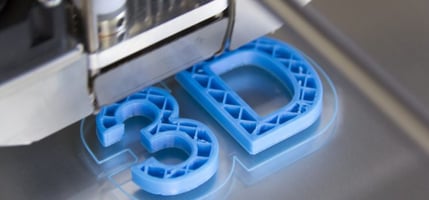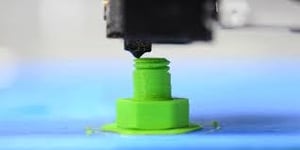Share this
3D Printing: 3-D Printing a Toy, a Trend, or Something Useful?
by Robert McNicholas on July 28, 2014
 As of July 15, Home Depot has begun selling MakerBots—3-D printers designed for nonindustrial use. For now, these will be available at selected stores and online. So what’s all this about 3-D printing? Is it a fad, or does it have a practical application? Let’s find out.
As of July 15, Home Depot has begun selling MakerBots—3-D printers designed for nonindustrial use. For now, these will be available at selected stores and online. So what’s all this about 3-D printing? Is it a fad, or does it have a practical application? Let’s find out.
A Very Short History Of 3-D Printing
Actually, 3-D printing has been around for a long time. Its technology and overall concept date back to the 1980s. For many years, 3-D printing was firmly in the domain of prototyping and parts manufacturing.
There are several forms of 3-D printing. The kind that MakerBot and other home-oriented products provide is known as fused deposition modeling. It’s a type of additive manufacturing that relies on fusing layer upon layer of a plastic-like material to create an object.
 Home enthusiasts with technical know-how have been able to buy kits and build their machines for a few years now. In 2012 and 2013, MakerBot and other 3-D printing companies began offering home-sized models at a family-sized budget; the printers it provides today are mostly in the $2,000 - $3,000 range.
Home enthusiasts with technical know-how have been able to buy kits and build their machines for a few years now. In 2012 and 2013, MakerBot and other 3-D printing companies began offering home-sized models at a family-sized budget; the printers it provides today are mostly in the $2,000 - $3,000 range.
How 3-D Printing Works
If your inkjet printer shot out a threadlike substance instead of liquid ink, it would share the same basic concept as a 3D printer. Here’s the process:
- A 3-D image or object is scanned or programmed into the printer.
- Filament-based printers, like the MakerBot, heat up and extrude thin streams of flexible material through a small nozzle, one layer at a time. Heat causes them to fuse to the previous layer.
- The printer continues to work, layer over layer, until the object is finished. Colors can be added during the process if the printer supports using more than one type of filament, or the object can be sanded and painted later.
So, is 3-D Printing a Toy, a Trend, or Something Useful?
At first glance, 3-D printing seems to be limited to two applications: prototype and hobby. But that’s not all it can do. Here are some other nifty ways this technology is being used:
- Food. 3D food printers, such as Foodini, use a thin paste of real food ingredients to turn out pizzas, chocolates, candy, veggie burgers, and more.
- Concept Cars. Honda has downloadable, printable concept cars available for 3D printers.
- Artificial Limbs and Bio-Replacements. So far, only the artificial limbs are available. According to The Guardian, they’re being used to help heal injured children in war-torn places. Other “replacement parts” for the human body are in the design process.
- Shoes, clothes, and jewelry. All of these are popular with 3D printing hobbyists, as are toys and figurines.
- Replacement parts on-demand, especially for scarce or legacy parts. This is actually very close to the original use of 3D printing.
- And, in time, houses. It hasn’t been done yet, but scientists are trying to re-imagine 3D printing as a faster and more efficient home-building technique.
For more on 3D printing, see articles from:
Share this
- Featured (119)
- Best Practices (76)
- Business (67)
- Small Business (67)
- Security (38)
- Managed Services (29)
- Business Growth (27)
- Technology News (26)
- Google For Work (22)
- it support (15)
- Social Media (13)
- Technology (11)
- Malware (10)
- Google (9)
- News (9)
- Cloud (6)
- seo (6)
- Backup Storage (5)
- Website (5)
- Communication (4)
- Productivity (4)
- Ransomware (4)
- Research (4)
- Analytics (3)
- Technology Support (3)
- Windows (2)
- anti malware (2)
- email (2)
- how to (2)
- laptops (2)
- mobile (2)
- Hubspot (1)
- data recovery (1)
- twitter (1)
- April 2024 (2)
- March 2024 (2)
- November 2022 (3)
- October 2022 (1)
- September 2022 (3)
- August 2022 (3)
- December 2021 (3)
- November 2021 (3)
- October 2021 (1)
- September 2021 (3)
- August 2021 (3)
- July 2021 (1)
- March 2021 (1)
- February 2021 (7)
- January 2021 (1)
- March 2020 (1)
- August 2019 (1)
- April 2019 (4)
- March 2019 (6)
- December 2018 (10)
- November 2018 (10)
- August 2018 (1)
- July 2018 (9)
- June 2018 (4)
- May 2018 (4)
- October 2017 (3)
- September 2017 (6)
- August 2017 (6)
- July 2017 (12)
- June 2017 (12)
- May 2017 (3)
- March 2017 (5)
- February 2017 (2)
- August 2016 (2)
- June 2016 (4)
- January 2016 (1)
- December 2015 (3)
- November 2015 (3)
- October 2015 (3)
- September 2015 (3)
- August 2015 (2)
- July 2015 (4)
- June 2015 (3)
- May 2015 (2)
- April 2015 (1)
- March 2015 (1)
- February 2015 (1)
- January 2015 (2)
- November 2014 (4)
- October 2014 (11)
- September 2014 (5)
- August 2014 (6)
- July 2014 (7)
- June 2014 (8)
- May 2014 (3)
- April 2014 (3)
- March 2014 (2)

